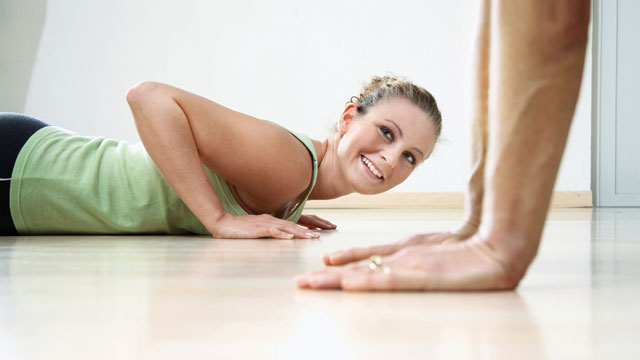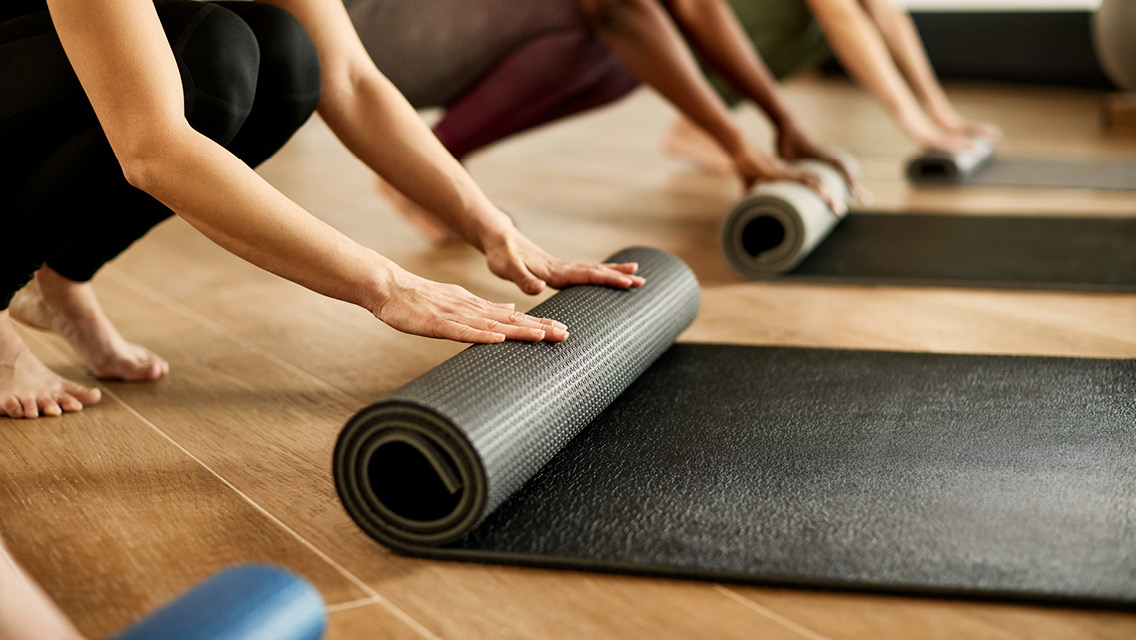Every week, Monday through Friday, Cindy Gendry rises at 4:45 a.m., and before she starts her workday, she hits the gym in her office building for a 90-minute workout. “It’s convenient, and I know it’s going to give me energy for the rest of the day,” says the 39-year-old Chicagoan. “Plus, it gives me muscular definition, which I like.”
Those basic benefits were enough to get Gendry to the gym for quite some time, but at some point, they started to seem less compelling than usual. “I was feeling bored. I wasn’t getting any additional results,” Gendry recalls.
With her fitness satisfaction fading, Gendry realized she needed to make some changes, and fast. Her solution was to shake up her usual lifting routine, opting for a more demanding program with higher weights and fewer reps per set.
In Gendry’s case, this simple upgrade seemed to do the trick. “I don’t feel satisfied unless I feel a little muscle soreness afterward,” Gendry explains. “That’s what tells me I had a good workout.”
For some, it may be the telltale twinge of sore muscles. For others, it may be the pleasure of getting to a new place on a climbing wall, and for others, it may be the peacefulness of an early-morning run through a sleeping neighborhood. What brings each of us a sense of fitness satisfaction is as individual, and as variable, as our personalities.
Once we’ve experienced satisfaction in one area of fitness, it’s our human tendency to want to pursue another. So for many of us, the face of fitness pleasure might be constantly morphing. Generally, though, a satisfying fitness program is one that challenges you physically, strengthens you emotionally and improves the quality of your life.
Sources of Fitness Satisfaction
Examining the specific factors that influence your own sense of fitness satisfaction can help you create a well-rounded exercise program that’s enjoyable – and productive. Fitness satisfaction begins with your priorities: What do you want out of the time and effort you’ve put into your workouts? Some of the most common primary aims people have in getting fit: visible physical changes, the thrill of competition and performance, better physical health, and an improved mood and outlook.
See if you identify with the characteristics (and caveats) of one or more of the following:
1. Physical transformation. Some of the most satisfying paybacks of a fitness routine are visible from the outside – and they’re often the ones that people notice and comment on. You may see weight loss or improvements in muscle tone within six to 12 weeks of starting an exercise routine. Just keep in mind that you’re likely to see more dramatic changes early in your workout program. As time goes by and you become fitter and leaner, improvements come in smaller increments.
2. Improved speed, endurance and stamina. Besting your personal records for race times and distance can provide great satisfaction. Keeping a workout journal in which you record workout and performance details (such as time, distance and heart rate) can help you track your progress. But you don’t have to be a competitive athlete to get deep pleasure out of performance gains. To get performance satisfaction, it’s important to be constantly challenging yourself (ideally using some kind of annual or seasonal periodization program).
3. Health improvements. The health benefits of exercise can be enormously satisfying, especially if you have a family history of heart disease, cancer, diabetes or other conditions. Consider setting measurable objectives, such as, “I want to be able to work an eight-hour day without being uncomfortable.” Or, “I want to get my blood pressure in the normal range by next Christmas.” When in doubt about what’s realistic, get guidance from a doctor.
4. Mental or emotional rejuvenation. Research shows that regular exercise lifts mood and reduces anxiety and depression. In fact, a Duke Medical Center study of 156 men and women found that a program of regular aerobic exercise was just as effective as medication in reducing symptoms of depression. Fitness can provide all sorts of spiritual, emotional and biochemical benefits that make us feel, think and perform better in our daily lives. Being more comfortable in your body can lead to peace of mind. Or you may find satisfaction in exercise by knowing that you are setting a positive example for your children. Working out with a friend or spouse provides a chance to strengthen your relationship.
The Keys to Consistent Exercise Adherence and Satisfaction
This all sounds great, of course. But daily exercise may not always seem like huge fun. Knowing the benefits you’re after, though, and recognizing the moments of pleasure you get in return for your hard work, can help make exercise feel more worthwhile.
The more content you are with your workouts, the more likely that you’ll keep the faith with your routine, demonstrating what researchers call “exercise adherence.”
Other influences on exercise adherence include convenience, social support and intrinsic motivation. The weight of these factors varies widely among individuals, though. Identifying and embracing the factors that are significant to you (for more on this, see “The Elements of Satisfaction,” below) will make you more likely to stick with your routine – and get more satisfaction out of both your process and your results.
1. Convenience.
Lack of time is the most common excuse offered for not working out. To help you find the time for exercise, psychologist Ann Kearney-Cooke, PhD, coauthor of Change Your Mind, Change Your Body suggests drawing a circular pie chart with 24 wedges that represent how you spend the hours in a typical day. Then make a second chart that reflects how your schedule will change to reflect your workout time.
Your original chart, for example, might include an hour to shower, get dressed and eat breakfast; nine hours for commuting and work; an hour for dinner; three hours for family time; an hour for household chores; two hours of television; and seven hours for sleep. On your second chart, you might give up an hour of television or look for ways to reduce the time you spend on work around the house.
“It’s very powerful for people to actually say, ‘I’m going to wake up a half-hour earlier,’ or ‘I’m going to cut out this thing,'” Kearney-Cooke says. “You really just have to make some choices.”
2. Self-efficacy.
Your belief in your abilities counts for a lot: The more confident you are that you’ll be able to finish a challenging group fitness class or complete a marathon, for example, the more likely you are to actually do it. Your belief in your performance plays a big role in how effective you are and also in how satisfied you are in the process.
Self-efficacy (basically, a sense of optimism about our own competence) governs the choices we make, the goals we set, the effort we put forth, how long we persist in the face of obstacles and how we feel about what we’ve accomplished. In a study done by researchers at the University of Illinois, 46 female college students were divided into two groups and given fitness tests. Regardless of performance, one group was told they’d placed in the top 20th percentile for fitness; the other, that they fell in the bottom 20th percentile. Several days later, they were reminded of their performance and asked to exercise again.
The women who believed they’d performed well reported more positive well-being after the second workout than those who were told they had performed poorly. This suggests that your attitude about your fitness and ability affects how you feel about the results of your workouts. If you lack confidence, consider working with a trainer who can help bolster your attitude, or join a supportive group fitness class, or try tracking your workouts so you have clearer evidence of your progress and improvement.
3. Social support.
Social support can make an enormous difference in your overall satisfaction with your program. A 2003 survey of 363 college students conducted at Arizona State University found that the students with the most social support exercised more than those without such support. In 2002, a study of 60 cardiac rehabilitation patients at Case Western Reserve University found that social support was the primary predictor for sticking with an exercise program.
If you don’t have a lot of support at home, consider partnering with an exercise buddy. That’s how Jill Browning, 36, manages to get up before 5 a.m. to exercise. “I’ve had a swimming buddy for over a year and a half, and it’s made a huge difference in my ‘stick-with-it-ness,'” says the mother of three, who lives in Downers Grove, Ill. “I’m as committed to the friendship as I am to the exercise itself.”
4. Intrinsic motivation.
“We’re more apt to keep goals that we set if they are in sync with our core values,” says Kearney-Cooke, who works with mothers and their teenage daughters to help them meet their fitness goals. She encourages her clients to take a closer look at their life goals and fitness goals to see how they mesh. A woman who sets a high priority on being a good parent, for example, is more likely to stick with regular exercise if she believes it will benefit her parenting abilities.
A Map for Making It
All of us know the satisfaction that comes with achievement, whether it’s nailing a long-sought promotion or finally finishing that home-improvement project. Achievement begins with setting goals and with deciding which aspects of your fitness program are the most important to you.
Start with general goals, then narrow your focus to figure out how you’ll measure them.
- Is your primary motivation to improve your endurance and have more energy during the day?
- To recapture your postpregnancy body?
- To run a 5K in less than 22 minutes?
Keep in mind that your goals should be reasonable. Lowering your resting heart rate from 80 to 75 in three months is doable; dropping it to 60 in that time is probably a stretch.
Most experts suggest writing down your goals. Steven Aldana, PhD, professor of lifestyle medicine at the College of Health and Human Performance at Brigham Young University and author of The Culprit and the Cure, takes that suggestion one step further and advises people to sign the goals they’ve committed to paper, preferably in front of a witness, like a spouse or friend.
“We live in a world where contracts carry a lot of power,” Aldana explains. “[Signing your goals] is an expression of a deep level of commitment.” Let your witness know what you’d like him or her to do to help, whether it’s being your workout partner or giving you a gentle nudge out the door.
Strategies for Overcoming Obstacles, Boredom, and Plateaus
No matter how motivated you are, you’ll still skid into obstacles from time to time. Plan now for how you’ll deal with conflicts in your routine, like business trips, sick kids or the American Idol finale. Aside from time constraints, some of the most pervasive problems are boredom and frustration.
At the beginning of your fitness program, health benefits and physical changes may be enough to keep you going. But if you get bored or stop seeing results, you’re more likely to quit. So don’t suffer through ho-hum workouts.
If you’ve been dedicated to a particular activity for years, switching your routine can be beneficial – especially mentally. “If you’re in a fitness rut, or you tried a new activity but just didn’t like it, don’t be afraid to give something else a try,” says Fritz Huber, chair of the health, physical education and recreation department at Oral Roberts University in Tulsa, Okla. Ask one of the certified personal trainers or fitness instructors at your club for variations or new activity suggestions. Go “just as a tourist” to a fitness class you’ve been curious about.
You’ll find that building variety into your program also helps ward off frustrating exercise plateaus. The first few months of a fitness program generally produce great gains. But as your body adjusts to training, you’ll have to keep working harder for those improvements to continue.
When visible improvements tail off, it can be helpful to have other types of feedback to fall back on. Try using a heart-rate monitor for cardio workouts. It will provide instant data and confirm that you’re working as hard as you should. It’s also a great way to ensure that you’re not exercising too intensely, particularly on planned recovery days, which can lead to overtraining and fatigue.
Finally, consider whether your goals are too ambitious for your current lifestyle and fitness level. If you’re swamped at work, you may have to table your marathon plans. Or if your goal is to have the willowy body of a supermodel but you’re gifted with a short, stocky frame, it’s time to get realistic about what you can accomplish – such as reducing your body-fat percentage or improving your muscle tone – rather than hoping for longer legs.
Satisfied for Life
The great thing about fitness satisfaction is that it’s self-perpetuating. A consistent fitness routine very easily becomes its own reward. Stephanie Stephens, who divides her time between Laguna Niguel, Calif., and Cambridge, New Zealand, has been a die-hard exerciser for more than 30 years. She’s swum, she’s skied, she’s run. Today, at 52, she rides a 17-hand show-jumper horse in addition to maintaining a regular weight-lifting and cardio schedule. Fit-ness is an integral part of her identity.
“Sometimes working out is inconvenient or boring,” she acknowledges. “But I think each of us has a responsibility to ourselves. We can make excuses, or we can do what we have to do in order to be who we want to be.”
Even if you’ve never considered yourself the athletic type, you’ll find that your mindset changes when satisfaction becomes an integral part of your workouts. “It’s just like eating breakfast for me now,” says Gendry, who is committed to exercising for life. “It’s part of my everyday routine. The thought of not being active is depressing!”
Both fitness satisfaction and lifetime satisfaction are made up of individual events and experiences, not just a set of happy outcomes. Each time you work out, you confirm that you are making fitness a priority for life. Sure, looking good is a terrific bonus for every active person. But for many, fitness satisfaction isn’t defined by physical appearance.
And even among those who initially choose to become fit because they want to look better, it’s not uncommon for them to discover that the real key to satisfaction lies in how they feel about themselves and their fitness program.
At best, a commitment to physical activity is a reflection of your values about health, vitality and integrity. Like true beauty, fitness satisfaction comes from inside.
The Elements of Fitness Satisfaction
What makes for a pleasing and results-producing fitness plan? Here’s a short list of items that every satisfying plan requires.
- Just enough challenge: The duration and intensity of your workouts should produce sweat, but not lasting frustration or pain.
- A positive attitude: A can-do outlook is essential to achieving fitness satisfaction. Respect yourself and be realistic about results. Don’t expect instant progress. Enjoy the journey.
- Clarity about goals: What’s your aim? Do you want a body that’s stronger, lighter, healthier, sexier? A life that’s more relaxed, energized, and full of confidence and accomplishment? Write down your goals and refer to them regularly.
- Measurable benchmarks: List the actions necessary to get to your goals, making them as concrete as possible in terms of time, distance and other factors (e.g., “My goal is to work out four times a week and attend at least three yoga classes a month”). Draft a timeline for desired progress, too.
- Appealing activities: Pick exercises that fit your personality and that give your mood a lift when you think about or picture yourself doing them.
- Convenience and comfort: You’re less likely to skip a day if you designate a regular time and place for exercise. The less rigmarole, the better.
- A balanced approach: Like choosing a meal from a menu, you’ll want to select a balance of strength, endurance and flexibility components in your routine. Together, the three result in synergetic gains, reduce your risks of injury and produce feelings of well-being.
- Feedback and figures: The mirror and scale can tell you only so much. Use a heart-rate monitor or a simple exercise log to help quantify your improvements in other ways. Regular fitness assessments (available at better health clubs) can deliver even more comprehensive benchmark data.
- Scheduled maintenance: Adopting a routine that adds weight or minutes to your workout every week or two lends physical and mental challenges to otherwise static regimens.
- Variety and surprise: Vary the intensity of your cardio routine by adding intervals once a week. Or try something that won’t be a cinch – jumping rope instead of biking, or yoga instead of your usual post-run stretching exercises.
- Sustainability: The best kind of exercise breeds an appetite for more. It doesn’t break you down or lead to injuries. It makes you stronger, healthier and more motivated as you go.
Body-Mind Magic
For many people, there’s a special kind of satisfaction that comes from strengthening the ties between mind and body. Perhaps as a result, the popularity of mind-body fitness options, like yoga, Pilates, qigong and tai chi, are on the rise.
In 2002, roughly 11 million Americans were practicing yoga or tai chi, according to the most recent statistics from American Sports Data; more than 4.6 million were doing Pilates. Along with physical exertion, such practices offer many adherents personal insight, calm and peace of mind.
Mind-body practices target your inner focus, helping you achieve a relaxed, meditative state of mind. “Through awareness, we are able to observe not only our physical movement but also the internal dialogue that accompanies such movement,” says Cameron Shayne, founder of Budokon International, a Pacific Palisades, Calif.–based organization that promotes a holistic-training method combining martial arts, hatha yoga, meditation and nutrition. “Any physical practice that brings awareness of one’s own habits – both physically and emotionally – strengthens the mind-body connection,” Shayne says.
Those who embrace this kind of integrated approach say the discipline and focus associated with mind-body practice improves their ability to cope with everyday stress and enhances their overall well-being. In addition to enjoying the physical changes, people experience spiritual growth and emotional strength.
“The word ‘fitness’ conjures images of strong bodies,” Shayne says. “But mind-body methods can do wonders for the practitioner’s satisfaction, because they nurture your emotional health as well as your physical health.”
In fact, the physical benefits of psychosocial mind-body interventions have been well documented. For example, a review study published in 2003 in The Journal of the American Board of Family Practice showed that mind-body therapies like meditation and hypnosis are often effective in treating medical problems ranging from headaches to arthritis and even coronary artery disease.
This article originally appeared as “Feeling Groovy: A Fitness Primer.”




This Post Has 0 Comments